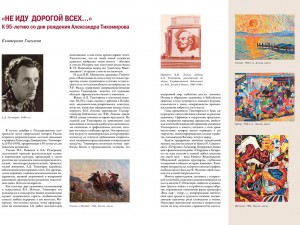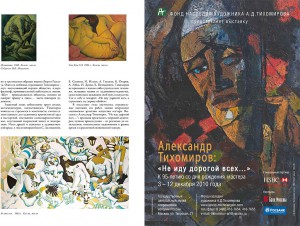Ekaterina Gogoleva
Russian art magazine, № 4, 2010
Retrospective exhibition of pictorial and graphic art of Alexander Dmitrievich Tikhomirov (1916-1995), devoted to the 95th anniversary of the birth of the artist will be opened at the State Central Museum of Contemporary History of Russia in the beginning of December.
A student of I.G. Ryzhenko and A.A. Osmyorkin, having acquired firm realistic background and art culture and having passed the stages of impressionism, post-impressionism and fauvist art in his development, A.D. Tikhomirov worked out his own unique style. His paintings amaze with complex compositional structure, powerful energy and inner dynamics, unique plastic solutions and rich color palette.
As noticed by the friend of the artist, completist and art expert V.A. Matveev, Tikhomirov “does not fit into the standards: his canvas show wild music, mad passion and extraordinary strong love. Interestingly enough, his canvas have a very strict, concise composition. He liked diagonal compositions which hold the canvas extremely well. It is amazing how much could be depicted on such a small space – striking with dimension and power. It was not for pure coincidence that our famous art expert V.N. Moskvinov called him “Soviet Michelangelo”, and it’s difficult to argue with him.”
And while V.N. Moskvinov compared Tikhomirov with Michelangelo, having in mind not only his terrific knowledge of plastics of a human body, but also the scale of his art, R.R. Fahlk, who gave high appraisal to Tikhomirov’s impressionist paintings, noticed that the artist possesses “a French eye” in art.
A.D. Tikhomirov’s life in the Soviet art of the 50-70-s is related with his work at the Moscow Decorative and Monumental Art Concern, where he painted portraits of V.I. Lenin for decoration of the State Library named after V.I. Lenin, building of the Ministry of Foreign Affairs and streets of the capital during the celebrations. But throughout entire life, main place in Tikhomirov’s art has always belonged to his work on paintings and graphic works which he created between his orders. These paintings have never been exhibited before perestroika, as they did not comply with requirements of social realism and perceptions about contemporary art in those days. Tikhomirov was deeply concerned about eternal problems of being and the purpose of a man, his inner world and depths of his subconscious. That’s why he appealed to the Biblical scenes, themes of true and false insanity, loneliness in a crowd, cast aside, confrontation of good and evil.
Years, spent by Tikhomirov in Baku, where he was born, had a big influence on development of the artist. Circus and theatric performances, colorful city celebrations, unusual processions of dervishes, whipping themselves, – everything seen by Tikhomirov in his younger years made strong impression on him, and found reflection in his paintings through oriental, circus and theatre themes, formed at a later stage.
Being a great connoisseur of the classical music, Alexander Dmitrievich was so inspired by Stravinsky’s ballet “Petroushka”, that he created a series of paintings “Petroushka and Ballerina”. He devoted these colorful and dynamic paintings to his muse – his wife Natalya Vinogradova. Being a broadminded person, possessing profound knowledge of art history, Tikhomirov was interested in theatre and cinema, highly appreciating the movies of Federico Fellini which attracted him with their theatricality.
Many of his paintings on theatric themes are full of reminiscences from Shakespeare’s plays and sonnets, so much admired by the artist. Looking at his paintings, spectator can find entire gallery of images reflecting famous phrase of the play-writer: “All the world’s a stage…”, interpretation of poetic idea of correlation between the eyesight and spiritual vision – sighted person can be spiritually blind; ambiguous perception of the role of dreams in life. Some of his paintings and graphic works on the theme of expulsion, pilgrimage refer us to tragic characters of Ling Lear and Hamlet. One of Tikhomirov’s favorite characters is motley, laughing at vices of the society, clown-philosopher, keen observant of life. “Motley belongs to the society. It’s him who tells the truth into your face” – the artist used to say.
Known only to a small circle of colleagues, completists and art experts, Tikhomirov has never striven to become famous, considering diligent work in the studio, continuous self-improvement, endless creative search and experiment to be the most important for an artist. Having friends and acquaintances in the artistic environment, including such painters as S. Adlivankin, E. Simkin, I. Ilyin, A. Gluskin, B. Otarov, A. Labas, I. Drize and B. Pikhansovich, Tikhomirov has never joined any groups or movements, being one of the artists undertaking independent search of their way in art. And that’s how he referred to himself: “I’m not walking the path of the many, but seek to avoid it.”
A number of personal exhibitions of his works took place in recent years, allowing Moscow audience to re-discover the art of the master. Exhibition “I’m not walking the path of the many…” will present the best works of the artist – from realism to neoclassic, created in different years and in various painting manner.

